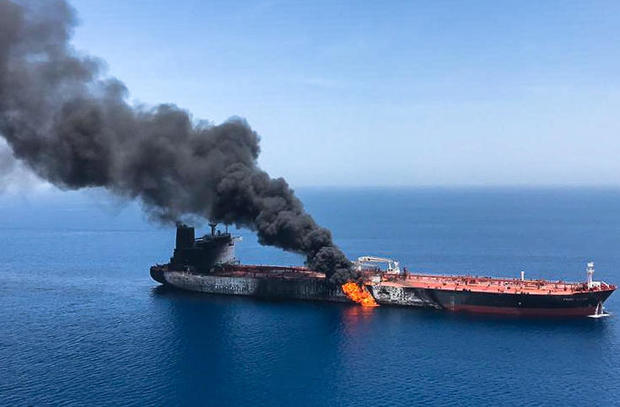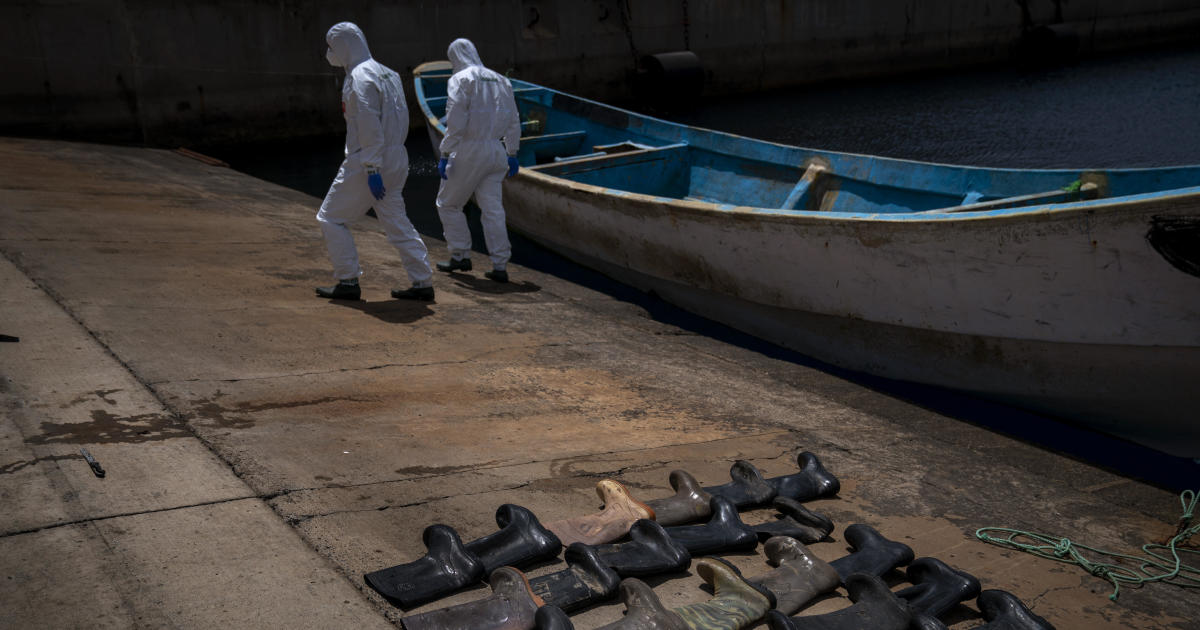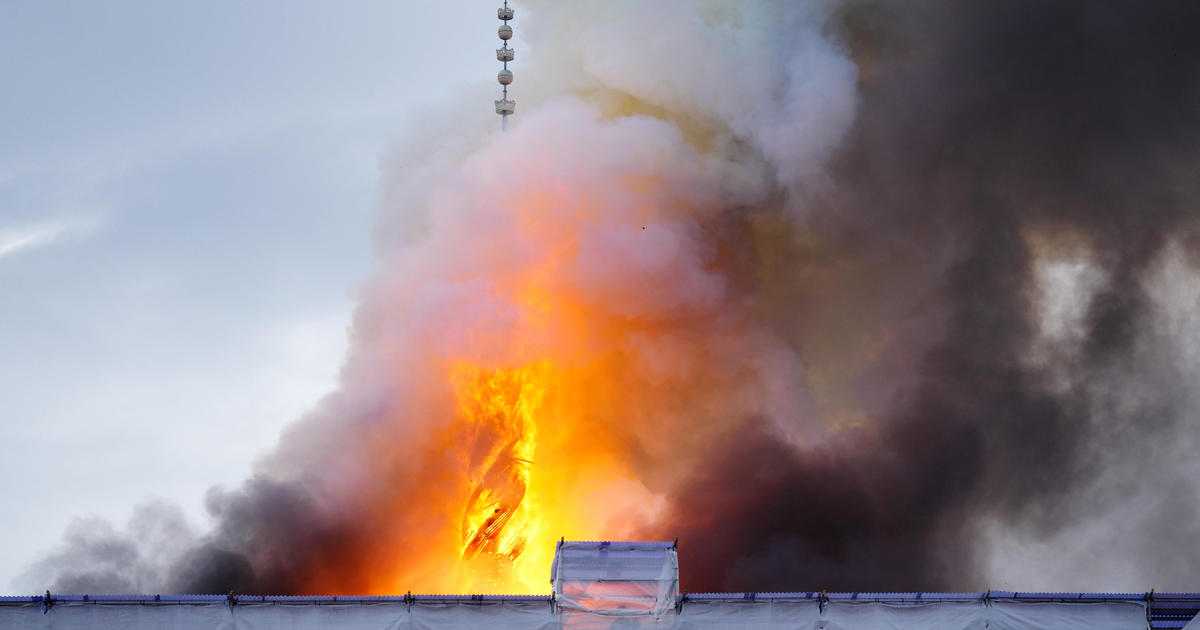U.S. intel says Iran tried to pick up crews from tankers attacked in Gulf of Oman
Shortly after the crews of the two tankers attacked this week in the Gulf of Oman evacuated their stricken vessels, the ships that rescued them were surrounded by Iranian military boats and told to transfer the mariners into their custody, according to declassified U.S. intelligence reports obtained on Friday by CBS News.
One of the civilian rescue ships eventually complied with the Iranian military's request. The other did not. The new details help to paint a picture of what happened Thursday in the Gulf, near the vital shipping channel of the Strait of Hormuz, through which about a third of the world's oil supply passes.
The U.S. has accused Iran of carrying out the attacks on the tankers — the second similar incident blamed on Iran in a month. Secretary of State Mike Pompeo called it "the latest in a series of attacks started by Iran and its surrogates against American and allied interests" aimed at "escalating tension."
He said the U.S. would defend its forces and interests in the region but gave no specifics about any plans for retaliation, and he took no questions.
A U.S. defense official quickly dismissed an Iranian claim on Thursday, soon after the attacks, that Iran sent search teams that rescued 44 sailors from the two vessels. The official told CBS News that claim was "patently false," and that it was an American destroyer, the USS Bainbridge, that picked up 21 crew members from one of the vessels.
The intelligence reports obtained by CBS News on Friday include a readout from the crew of the Hyundai Dubai, an oil tanker that came to the rescue when the stricken Front Altair issued a distress call after an explosion on Thursday. The crew of the Norwegian-owned Altair came aboard the Hyundai Dubai, according to the detailed readout from the rescuing vessel's crew.
About 10 minutes later, the Hyundai Dubai "was surrounded by Iranian military vessels who demanded the Ship's Master turn over the M/V FRONT ALTAIR mariners," according to the readout.
The captain of the vessel contacted his company's management, which told him to refuse the Iranian request, but the readout says he "stated he felt like he had no choice but to comply with Iranian demands" and he did hand the Front Altair's crew over to the Iranian vessels. The sailors, most of them Russian and Filipino, were taken to Iran and remained in Iranian custody, the Front Altair's owner Frontline told Reuters on Friday.
The other tanker that came under attack on Thursday was the Japanese-owned Kokuka Courageous, which issued a distress call after sustaining an explosion that caused a fire in its engine room.
The readout from the crew of the Kokuka said a Dutch vessel responded and positioned itself to inspect the damage to the tanker.
"The Dutch vessel reported to the Master an unusual object on the Starboard side, mid-ship, of the KOKUKA. The crew looked over the side and noticed an object they believed to be an explosive. Due to the ship carrying methanol and already suffering one explosion, the Master ordered the crew to abandon ship," according to the intelligence briefing.
The Dutch vessel took the sailors from the Kokuka aboard and moved to a safe distance.
The crew of an Iranian military vessel then asked the Dutch ship for permission to board, "so they could transfer personnel and render assistance to the crew. The Master of the KOKUKA spoke to the owner of his vessel and was instructed not to go aboard the Iranian vessel so he declined aid and thanked them."
Leftover limpet mine?
The crew of the Dutch vessel and the Kokuka were able to see attached to the tanker, as they moved away from it, a "grey explosive," described as being about five feet wide and three feet tall, which the sailors said was protruding from the hull, three to six feet over the waterline.
U.S. officials have accused Iran of using limpet mines in the attacks this week — the same magnetic explosive devices allegedly used by Iranians in attacks on four tankers in the region last month. The devices can be affixed to the hull of a vessel, and can cause significant damage to a ship. They have not, however, been powerful enough to breach the double hulled vessels sufficiently as to capsize them.
The U.S. military said Thursday it had a video showing troops from Iran's Revolutionary Guard removing an unexploded limpet mine from the Kokuka. The black-and-white video, as well as still photographs released by the U.S. military's Central Command, appeared to show a limpet mine on the Kokuka.
A U.S. official told CBS News senior national security correspondent David Martin on Friday that the U.S. had a forensic team aboard the Kokuka Courageous as it was being towed to port. Parts of the magnet which held the mine to the ship were still attached to the tanker's hull.
The official told CBS News that a commercial tug boat was sent to tow the Front Altair to port also, but that Iranian Navy vessels were preventing it from tying up to the tanker.
Why would Iran attack an oil tanker?
The waterways in the region are crucial to the global transportation of oil and gas: A third of all shipped oil comes through the area, and because the Strait of Hormuz, the narrow waterway near where the attack took place, is right off the coast of Iran, it's a point of leverage for the country.
Iran has repeatedly threatened to cut off this vital artery whenever there is a dispute with the U.S. or its regional allies, such as Saudi Arabia and the United Arab Emirates. Tension between Iran and the U.S. has mounted steadily since the Trump administration's unilateral withdrawal from the 2015 nuclear agreement negotiated by the previous occupant of the White House.
As CBS News reported in early June, the admiral of the USS Abraham Lincoln, an aircraft carrier in the region, said one of his ship's primary missions is to safeguard the free flow of commerce through the Strait and the surrounding waterways. The Lincoln was sent specifically because of perceived threats from Iran — but as CBS News correspondent Charlie D'Agata reported on Thursday, it doesn't appear to be proving much of a deterrent.
"On April 22nd, Iran promised the world it would interrupt the flow of oil through the Strait of Hormuz. It is now working to execute on that promise," Pompeo said Thursday.
Iran flatly denies any involvement in the tanker attacks, and has called the timing of Thursday's incidents "suspicious" as they came just as the Japanese leader was in Tehran trying to rekindle diplomacy.
Other nations, and the United Nations, have stressed the need to avoid "accidental" escalations in the region.
"I want to say how worried I am with the recent developments in the Gulf," United Nations Secretary-General António Guterres said on Friday. "We believe that the truth needs to be clearly established in relation to these attacks. We believe that responsibilities need to be clearly defined. And, as I said to the Security Council, the world cannot afford a major confrontation in the Gulf."
"It is very important to know the truth," Guterres said, before calling for "some independent entity" to verify the facts. He added that as secretary-general he cannot instigate an international investigation, but noted that the Security Council can.




